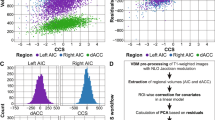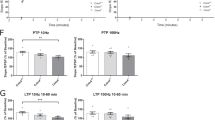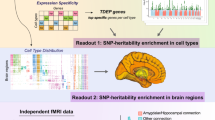Abstract
Genome-wide association studies have reported an association between NCAN rs1064395 genotype and bipolar disorder. This association was later extended to schizophrenia and major depression. However, the neurobiological underpinnings of these associations are poorly understood. NCAN is implicated in neuronal plasticity and expressed in subcortical brain areas, such as the amygdala and hippocampus, which are critically involved in dysfunctional emotion processing and regulation across diagnostic boundaries. We hypothesized that the NCAN risk variant is associated with reduced gray matter volumes in these areas. Gray matter structure was assessed by voxel-based morphometry on structural MRI data in two independent German samples (healthy subjects, n=512; depressed inpatients, n=171). All participants were genotyped for NCAN rs1064395. Hippocampal and amygdala region-of-interest analyses were performed within each sample. In addition, whole-brain data from the combined sample were analyzed. Risk (A)-allele carriers showed reduced amygdala and hippocampal gray matter volumes in both cohorts with a remarkable spatial overlap. In the combined sample, genotype effects observed for the amygdala and hippocampus survived correction for entire brain volume. Further effects were also observed in the left orbitofrontal cortex and the cerebellum/fusiform gyrus. We conclude that NCAN genotype is associated with limbic gray matter alterations in healthy and depressed subjects in brain areas implicated in emotion perception and regulation. The present data suggest that NCAN forms susceptibility to neurostructural deficits in the amygdala, hippocampus, and prefrontal areas independent of disease, which might lead to disorder onset in the presence of other genetic or environmental risk factors.
Similar content being viewed by others
Log in or create a free account to read this content
Gain free access to this article, as well as selected content from this journal and more on nature.com
or
References
Almeida JRC, Phillips ML (2012). Distinguishing between unipolar depression and bipolar depression: current and future clinical and neuroimaging perspectives. Biol Psychiatry 73: 111–118.
Amunts K, Kedo O, Kindler M, Pieperhoff P, Mohlberg H, Shah NJ et al (2005). Cytoarchitectonic mapping of the human amygdala, hippocampal region and entorhinal cortex: intersubject variability and probability maps. Anat Embryol (Berl) 210: 343–352.
Avram S, Shaposhnikov S, Buiu C, Mernea M (2014). Chondroitin sulfate proteoglycans: structure-function relationship with implication in neural development and brain disorders. Biomed Res Int 2014: 642798.
Baune BT, Konrad C, Grotegerd D, Suslow T, Birosova E, Ohrmann P et al (2012a). Interleukin-6 gene (IL-6): a possible role in brain morphology in the healthy adult brain. J Neuroinflammation 9: 125.
Baune BT, Konrad C, Grotegerd D, Suslow T, Ohrmann P, Bauer J et al (2012b). Tumor necrosis factor gene variation predicts hippocampus volume in healthy individuals. Biol Psychiatry 72: 655–662.
Beck AT, Steer RA (1987) Beck Depression Inventory: Manual. Psychological Corporation Harcourt Brace Jovanovich: San Antonio, TX, USA.
Blond BN, Fredericks CA, Blumberg HP (2012). Functional neuroanatomy of bipolar disorder: structure, function, and connectivity in an amygdala-anterior paralimbic neural system. Bipolar Disord 14: 340–355.
Blumberg HP, Kaufman J, Martin AA, Whiteman R, Zhang JH, Gore JC et al (2003). Amygdala and hippocampal volumes in adolescents and adults with bipolar disorder. Arch Gen Psychiatry 60: 1201–1208.
Brown GG, Lee J-S, Strigo IA, Caligiuri MP, Meloy MJ, Lohr J (2011). Voxel-based morphometry of patients with schizophrenia or bipolar I disorder: a matched control study. Psychiatry Res 194: 149–156.
Cichon S, Mühleisen TW, Degenhardt FA, Mattheisen M, Miró X, Strohmaier J et al (2011). Genome-wide association study identifies genetic variation in neurocan as a susceptibility factor for bipolar disorder. Am J Hum Genet 88: 372–381.
Dannlowski U, Grabe HJ, Wittfeld K, Klaus J, Konrad C, Grotegerd D et al (2014). Multimodal imaging of a tescalcin (TESC)-regulating polymorphism (rs7294919)-specific effects on hippocampal gray matter structure. Mol Psychiatry 20: 398–404.
Dannlowski U, Konrad C, Kugel H, Zwitserlood P, Domschke K, Schöning S et al (2010). Emotion specific modulation of automatic amygdala responses by 5-HTTLPR genotype. Neuroimage 53: 893–898.
Dannlowski U, Kugel H, Franke F, Stuhrmann A, Hohoff C, Zwanzger P et al (2011). Neuropeptide-S (NPS) receptor genotype modulates basolateral amygdala responsiveness to aversive stimuli. Neuropsychopharmacology 36: 1–7.
Dannlowski U, Ohrmann P, Bauer J, Kugel H, Arolt V, Heindel W et al (2007). Amygdala reactivity to masked negative faces is associated with automatic judgmental bias in major depression: a 3 T fMRI study. J Psychiatry Neurosci 32: 423–429.
Dannlowski U, Stuhrmann A, Beutelmann V, Zwanzger P, Lenzen T, Grotegerd D et al (2012). Limbic scars: long-term consequences of childhood maltreatment revealed by functional and structural MRI. Biol Psychiatry 71: 286–293.
Erk S, Meyer-Lindenberg A, Schnell K, Opitz von Boberfeld C, Esslinger C, Kirsch P et al (2010). Brain function in carriers of a genome-wide supported bipolar disorder variant. Arch Gen Psychiatry 67: 803–811.
Foland-Ross LC, Thompson PM, Sugar C a, Narr KL, Penfold C, Vasquez RE et al (2013). Three-dimensional mapping of hippocampal and amygdalar structure in euthymic adults with bipolar disorder not treated with lithium. Psychiatry Res 211: 195–201.
Fournier JC, Keener MT, Almeida JRC, Kronhaus DM, Phillips ML (2013). Amygdala and whole-brain activity to emotional faces distinguishes major depressive disorder and bipolar disorder. Bipolar Disord 15: 741–752.
Galtrey CM, Fawcett JW (2007). The role of chondroitin sulfate proteoglycans in regeneration and plasticity in the central nervous system. Brain Res Rev 54: 1–18.
Groenewold NA, Opmeer EM, de Jonge P, Aleman A, Costafreda SG (2012). Emotional valence modulates brain functional abnormalities in depression: evidence from a meta-analysis of fMRI studies. Neurosci Biobehav Rev 37: 152–163.
Grotegerd D, Stuhrmann A, Kugel H, Schmidt S, Redlich R, Zwanzger P et al (2014). Amygdala excitability to subliminally presented emotional faces distinguishes unipolar and bipolar depression: an fMRI and pattern classification study. Hum Brain Mapp 35: 2995–3007.
Grotegerd D, Suslow T, Bauer J, Ohrmann P, Arolt V, Stuhrmann A et al (2013). Discriminating unipolar and bipolar depression by means of fMRI and pattern classification: a pilot study. Eur Arch Psychiatry Clin Neurosci 263: 119–131.
Hajek T, Cullis J, Novak T, Kopecek M, Höschl C, Blagdon R et al (2012a). Hippocampal volumes in bipolar disorders: opposing effects of illness burden and lithium treatment. Bipolar Disord 14: 261–270.
Hajek T, Kopecek M, Höschl C, Alda M (2012b). Smaller hippocampal volumes in patients with bipolar disorder are masked by exposure to lithium: a meta-analysis. J Psychiatry Neurosci 37: 333–343.
Hartberg CB, Sundet K, Rimol LM, Haukvik UK, Lange EH, Nesvåg R et al (2011). Subcortical brain volumes relate to neurocognition in schizophrenia and bipolar disorder and healthy controls. Prog Neuropsychopharmacol Biol Psychiatry 35: 1122–1130.
Laux L, Glanzmann P, Schaffner P, Spielberger CD (1981) Das State-Trait Angstinventar. Beltz: Weinheim, Germany.
Lee SH, Ripke S, Neale BM, Faraone S V, Purcell SM, Perlis RH et al (2013). Genetic relationship between five psychiatric disorders estimated from genome-wide SNPs. Nat Genet 45: 984–994.
Lehrl S (1995) Mehrfachwahl-Wortschatz-Intelligenztest MWT-B. Hogrefe: Göttingen, Germany.
Lim CS, Baldessarini RJ, Vieta E, Yücel M, Bora E, Sim K (2013). Longitudinal neuroimaging and neuropsychological changes in bipolar disorder patients: review of the evidence. Neurosci Biobehav Rev 37: 418–435.
MacQueen GM, Frodl T (2010). The hippocampus in major depression: evidence for the convergence of the bench and bedside in psychiatric research? Mol Psychiatry 16: 252–264.
Miró X, Meier S, Dreisow MLM, Frank J, Strohmaier J, Breuer R et al (2012). Studies in humans and mice implicate neurocan in the etiology of mania. Am J Psychiatry 169: 982–990.
Mühleisen TW, Mattheisen M, Strohmaier J, Degenhardt FA, Priebe L, Schultz CC et al (2012). Association between schizophrenia and common variation in neurocan (NCAN), a genetic risk factor for bipolar disorder. Schizophr Res 138: 69–73.
Opel N, Redlich R, Zwanzger P, Grotegerd D, Arolt V, Heindel W et al (2014). Hippocampal atrophy in major depression: a function of childhood maltreatment rather than diagnosis? Neuropsychopharmacology 39: 2723–2731.
Pankow A, Friedel E, Sterzer P, Seiferth NY, Walter H, Heinz A et al (2013). Altered amygdala activation in schizophrenia patients during emotion processing. Schizophr Res 150: 101–106.
Phillips ML, Swartz HA (2014). A critical appraisal of neuroimaging studies of bipolar disorder: toward a new conceptualization of underlying neural circuitry and a road map for future research. Am J Psychiatry 171: 829–843.
Rauch AV, Reker M, Ohrmann P, Pedersen A, Bauer J, Dannlowski U et al (2010). Increased amygdala activation during automatic processing of facial emotion in schizophrenia. Psychiatry Res 182: 200–206.
Rauch U, Feng K, Zhou XH (2001). Neurocan: a brain chondroitin sulfate proteoglycan. Cell Mol Life Sci 58: 1842–1856.
Raum H, Dietsche B, Nagels A, Witt SH, Rietschel M, Kircher T et al (2015). A genome-wide supported psychiatric risk variant in NCAN influences brain function and cognitive performance in healthy subjects. Hum Brain Mapp 36: 378–390.
Redlich R, Almeida JRC, Grotegerd D, Opel N, Kugel H, Heindel W et al (2014). Brain morphometric biomarkers distinguishing unipolar and bipolar depression: a VBM—pattern classification approach. JAMA Psychiatry 71: 1222–1230.
Schultz CC, Mühleisen TW, Nenadic I, Koch K, Wagner G, Schachtzabel C et al (2014). Common variation in NCAN, a risk factor for bipolar disorder and schizophrenia, influences local cortical folding in schizophrenia. Psychol Med 44: 811–820.
Shen Y, Tenney AP, Busch SA, Horn KP, Cuascut FX, Liu K et al (2009). PTPsigma is a receptor for chondroitin sulfate proteoglycan, an inhibitor of neural regeneration. Science 326: 592–596.
Shepherd AM, Laurens KR, Matheson SL, Carr VJ, Green MJ (2012). Systematic meta-review and quality assessment of the structural brain alterations in schizophrenia. Neurosci Biobehav Rev 36: 1342–1356.
Siegle GJ, Thompson WK, Carter CS, Steinhauer SR, Thase ME (2007). Increased amygdala and decreased dorsolateral prefrontal BOLD responses in unipolar depression: related and independent features. Biol Psychiatry 61: 198–209.
Stacey D, Redlich R, Opel N, Grotegerd D, Arolt V, Kugel H et al (2014). No evidence of DISC1-associated morphological changes in the hippocampus, anterior cingulate cortex, or striatum in major depressive disorder cases and healthy controls. J Affect Disord 166: 103–107.
Stein JL, Medland SE, Vasquez AA, Hibar DP, Senstad RE, Winkler AM et al (2012). Identification of common variants associated with human hippocampal and intracranial volumes. Nat Genet 44: 552–561.
Strakowski SM, Adler CM, Almeida JRC, Altshuler LL, Blumberg HP, Chang KD et al (2012). The functional neuroanatomy of bipolar disorder: a consensus model. Bipolar Disord 14: 313–325.
Stratmann M, Konrad C, Kugel H, Krug A, Schöning S, Ohrmann P et al (2014). Insular and hippocampal gray matter volume reductions in patients with major depressive disorder. PLoS One 9: e102692.
Stuhrmann A, Dohm K, Kugel H, Zwanzger P, Redlich R, Grotegerd D et al (2013). Mood-congruent amygdala responses to subliminally presented facial expressions in Major Depression: associations with anhedonia. J Psychiatry Neurosci 38: 249–258.
Stuhrmann A, Suslow T, Dannlowski U (2011). Facial emotion processing in major depression: a systematic review of neuroimaging findings. Biol Mood Anxiety Disord 1: 10.
Suslow T, Konrad C, Kugel H, Rumstadt D, Zwitserlood P, Schöning S et al (2010). Automatic mood-congruent amygdala responses to masked facial expressions in major depression. Biol Psychiatry 67: 155–160.
Zilles K, Palomero-Gallagher N, Amunts K (2013). Development of cortical folding during evolution and ontogeny. Trends Neurosci 36: 275–284.
Author information
Authors and Affiliations
Corresponding author
Additional information
Supplementary Information accompanies the paper on the Neuropsychopharmacology website
Supplementary information
PowerPoint slides
Rights and permissions
About this article
Cite this article
Dannlowski, U., Kugel, H., Grotegerd, D. et al. NCAN Cross-Disorder Risk Variant Is Associated With Limbic Gray Matter Deficits in Healthy Subjects and Major Depression. Neuropsychopharmacol 40, 2510–2516 (2015). https://doi.org/10.1038/npp.2015.86
Received:
Revised:
Accepted:
Published:
Issue date:
DOI: https://doi.org/10.1038/npp.2015.86
This article is cited by
-
Phenotypes, mechanisms and therapeutics: insights from bipolar disorder GWAS findings
Molecular Psychiatry (2022)
-
Systematic misestimation of machine learning performance in neuroimaging studies of depression
Neuropsychopharmacology (2021)
-
Biological sex classification with structural MRI data shows increased misclassification in transgender women
Neuropsychopharmacology (2020)
-
Social anhedonia in major depressive disorder: a symptom-specific neuroimaging approach
Neuropsychopharmacology (2019)
-
Neurobiology of the major psychoses: a translational perspective on brain structure and function—the FOR2107 consortium
European Archives of Psychiatry and Clinical Neuroscience (2019)



